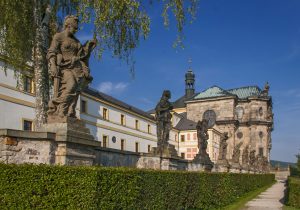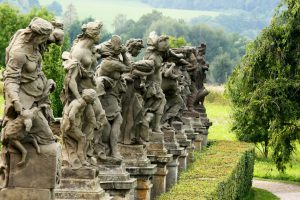Kuks: A variety of sights at the Baroque complex
By Tracy A. Burns
 Basking in Baroque glory, the former hospital Kuks offers a wide variety of sights, such as masterful statuary, an impressive church with chapel, a Baroque pharmacy, and even a pharmaceutical museum tracing the development of the field. Murals glorifying death also are sure to amaze.
Basking in Baroque glory, the former hospital Kuks offers a wide variety of sights, such as masterful statuary, an impressive church with chapel, a Baroque pharmacy, and even a pharmaceutical museum tracing the development of the field. Murals glorifying death also are sure to amaze.
The beginning of Kuks and its glory days
It all began when Count Franz Anton von Sporck, one of the most significant intellectuals of the 18th century, inherited the property in Bohemia in 1684. After discovering a spring, he decided to build a spa complex with a hospital. He envisioned his own small Versailles. Guests could watch plays and operas, in Italian and German, at the wooden theatre or borrow books from the extensive library in the Philosopher’s House, where Spork lived. Hunting and fishing were their favorite pastimes, too. Music and dance were no strangers to the spa, either. There was even a horse racing track and chateau.
Kuks after Count Spork’s death
After Sporck’s death in 1738, the complex deteriorated. A flood wreaked havoc in 1740. Only the hospital, the church, and the cascade of stairs remain. The Merciful Brotherhood took charge of the hospital, but they were evicted in 1938 when the Munich Agreement was signed because Kuks was located in the Sudetenland. The Munich Agreement ceded the Sudetenland, where there was a German-speaking majority, to the Reich. After the war, the Germans were expelled from the land. Later the hospital was used as a warehouse and school for delinquents. It was not until the end of the 1950s that people showed interest in preserving the former hospital. It was closed to the public in 2013. After a two-year reconstruction period, Kuks opened again in March of 2015, and now its Baroque splendor dazzles even more than before the renovation.
Braun’s statues
 A jewel in the Czech lands, the former hospital Kuks shows off 12 Baroque statues of virtues and 12 more of vices, created by the sculpting guru Matthias Bernard Braun in the 18th century. Among his many other accomplishments is a statuary grouping for the Charles Bridge. An elderly woman stares at bags of money; she represents Greed. A girl grips a heart – she is Sincerity. Wisdom has faced on both sides of the head. However, the statues outside are copies. To see the authentic statues, visitors must visit the lapidarium.
A jewel in the Czech lands, the former hospital Kuks shows off 12 Baroque statues of virtues and 12 more of vices, created by the sculpting guru Matthias Bernard Braun in the 18th century. Among his many other accomplishments is a statuary grouping for the Charles Bridge. An elderly woman stares at bags of money; she represents Greed. A girl grips a heart – she is Sincerity. Wisdom has faced on both sides of the head. However, the statues outside are copies. To see the authentic statues, visitors must visit the lapidarium.
Dance of Death murals
The 47 newly restored Dance of Death murals in the main hallway will amaze. Spork was fascinated by symbols of death. The works show people of various professions, such as a sailor, nuns, comedians,s and insane people face-to-face with death. Skeletons make frequent appearances. Underneath each picture is a verse in old German.
Other sights at Kuks
In the Chapel of the Assumption of the Virgin Mary, there is a large model of Bethlehem, dating from the 19th century. The resurrection of Lazarus is the theme of the main altar in the Holy Trinity Church. Visitors are treated to a concert of 14th-century music while seated in the church. The sacristy will delight as well. Hailing from 1711, the Baroque pharmacy is the second oldest in the country. Some of the jars once contained a fox’s lungs, opium, and atropine, a poison that could lead to blindness. A pharmaceutical museum is also on the premises. The crypt of Franz Anton von Sporck and his family holds 20 caskets. One of Spork’s servants is also buried there because she saved his life.
Braun’s Nativity and the 21st century Stations of the Cross
In the early 18th century Braun also created an outdoor gallery of statues and reliefs with biblical themes. Situated near Kuks, Braun’s Nativity is worth exploring on a sunny day. Also in the vicinity are 15 contemporary statues making up the 21st century Stations of the Cross, forged by three generations of Czech sculptors led by Vladimir Preclik. Two enormous hands are clasped in prayer. Three larger-than-life size angels captivate, too. There is no path along the sculptures; visitors must walk over the grass. Seeing the statuary in a natural environment makes the experience all the more profound. It has been open to the public since 2008.




